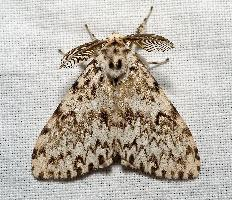
Poids et mesures
| Longueur | de 25 à 30 mm |
|---|
Statut de conservation
| Menacé |
Description de l'animal
The Rusty Tussock Moth, scientifically known as Orgyia antiqua, is a fascinating species within the moth family Erebidae, notable for its distinctive appearance and lifecycle. Native to Europe but found in various parts of the world due to human activity, this moth has garnered attention for both its beauty and the challenges it poses in forest management and agriculture.Adult male Rusty Tussock Moths exhibit a remarkable wing pattern, characterized by shades of brown, gray, and a hint of rusty color, from which the moth derives its common name. The males have a wingspan of about 30-40 mm and are adept flyers, unlike the females, which are wingless, a trait quite unusual among moths. The females are larger, with a stout, furry body primarily whitish or yellowish in color and spend their lives near the cocoon from which they emerged, relying on pheromones to attract males for mating.
The life cycle of the Rusty Tussock Moth is intriguing and begins when the female lays clusters of eggs on the underside of leaves or on tree bark. These eggs overwinter and hatch into caterpillars in the spring. The caterpillars are highly distinctive and easily identifiable, with a unique appearance that includes a dense covering of hairs, tufts, and four conspicuous toothbrush-like tufts along their backs. Two long tufts at the front and rear resemble antennae, making them one of the most visually striking caterpillars. The body is dark, adorned with red and yellow spots, adding to their distinctiveness.
These caterpillars feed on a wide variety of host plants, including but not limited to deciduous trees and shrubs like oak, birch, and hazelnut. This feeding can lead to significant defoliation, particularly in outbreak years, posing challenges for forest management and agriculture. After feeding and growing through several instars, the caterpillars pupate, often on the same plants they fed on.
Despite their beauty and fascinating biology, the Rusty Tussock Moth's caterpillars are known to cause skin irritation in humans due to their urticating hairs, which can lead to rashes and allergic reactions upon contact. This aspect, combined with their potential for significant plant damage, makes them a species of interest not only to entomologists and naturalists but also to those involved in agriculture and forest management.
In summary, the Rusty Tussock Moth is a species with a complex and intriguing life cycle, marked by significant differences between the sexes, a distinctive and colorful larval stage, and interactions with humans and the environment that are both beneficial and challenging.
Animaux similaires
Nouvelles photos d'animaux
Top 10 des animaux
- Dolphin gull (Leucophaeus scoresbii)
- Japanese macaque (Macaca fuscata)
- Stone loach (Barbatula barbatula)
- Greek tortoise (Testudo graeca)
- Russian tortoise (Testudo horsfieldii)
- Galápagos tortoise (Geochelone nigra complex)
- Diana monkey (Cercopithecus diana)
- Moustached guenon (Cercopithecus cephus)
- Common flying dragon (Draco volans)
- Galápagos penguin (Spheniscus mendiculus)
